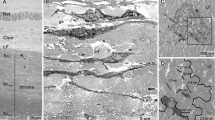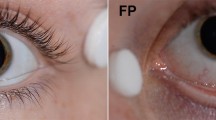Abstract
A 5,000 W Xe-Hg high pressure lamp and a double monochromator were used to produce a 3.3 nm half-bandpass ultraviolet radiation at 295 nm. Pigmented rabbit eyes were irradiated with radiant exposures from 140 Jm−2 to 10,000 Jm−2 and evaluated by slit-lamp biomicroscopy, light and electron microscopy. Corneal threshold (Hc) was 200 Jm−2 and lens threshold (HL) was 7,500 Jm−2. The most repeatable and reliable corneal response to these levels of UV was the development of corneal epithelial granules.
Histological changes included a loss of superficial epithelial cells and selective UV induced autolysis of the wing cells. It is suggested that the biomicroscopically observed granules are the clinical manifestation of the secondary lysosomes revealed by light and electron microscopy. It is proposed that UV breaks down the primary lysosome membranes to release hydrolytic enzymes which in turn form the secondary lysosomes during autolysis.
Extreme levels of radiant exposure at 295 nm result in indiscriminate destruction of all layers of the corneal epithelium, but the posterior cornea was spared.
Zusammenfassung
Mit Hilfe einer 5 000 W Xenon-Hochdrucklampe und einem Monochromator wurde eine UV-Bestrahlung bei 295 nm Wellenlänge mit einer Bandbreite von 6,6 nm durchgeführt. Dabei wurden die Augen pigmentierter Kaninchen Bestrahlungswerten zwischen 140 Jm−2 und 10000 Jm−2 ausgesetzt und spaltlampenmikroskopisch sowie licht- und elektronenmikroskopisch untersucht. Der Hornhaut-Schwellenwert (Hc) lag bei 200 Jm−2 und der Linsenschwellenwert (HL) bei 7500 Jm−2. Die konstantesten Veränderungen in der Hornhaut bei UV-Bestrahlungen in diesem Schwellenwertbereich waren das Auftreten von Granula im Hornhautepithel.
Weitere histologische Veränderungen bestanden in einem Verlust der oberflächlichen Hornhautepithelzellen und selektiver UV-induzierter Autolyse der sogenannten Flügelzellen. Es wird vermutet, daß die biomikroskopisch sichtbaren Granula die klinische Manifestation der licht- und elektronenmikroskopisch darstellbaren sekundären Lysosomen darstellen. Es wird angenommen, daß die UV-Bestrahlung zu einem Zusammenbruch der Membran primärer Lysosomen und damit zur Freisetzung hydrolytischer Enzyme führt, was die Bildung sekundärer Lysosomen während der Autolyse zur Folge hat.
Extreme Bestrahlungsdosen bei 295 nm führen zu einer nicht mehr abgrenzbaren Zerstörung aller Sichten des Hornhautepithels; Veränderungen an der Hornhautrückseite finden sich dabei allerdings nicht.
Similar content being viewed by others
References
Babel J, Leuenberger P (1971) Human keratitis herpetic: Ultrastructure of epithelial lesions before and after IDU treatment. Arch Ophthal (Paris) el, 717–726
Beaven GD, Holiday ER (1952) Ultraviolet absorption spectra of proteins and amino acids. Advan Protein Chem 7:319–386
Boettner EA, Wolter JR (1962) Transmission of the ocular media. Invest Ophthal 1 (6):766–783
Buschke W, Friedenwald JS, Moses SG (1945) Effects of ultraviolet irradiation on corneal epithelium: mitosis, nuclear fragmentation, post-traumatic cell movements, loss of tissue cohesion. J Cell Comp Physiol 26:147–164
Cogan DG, Kinsey VE (1946) Action spectrum of keratitis produced by ultraviolet radiation. Arch Ophthal 35:670–677
Cogan D, Kuwabara T, Donaldson D, Collins E (1974) Microcystic dystrophy of the cornea. Arch Ophthal 92:470–474
Daniels F Jr (1963) Ultraviolet carcinogenesis in man. InThe First International Conference on the Biology of Cutaneous Cancer (F. Urback, ed.), National Cancer Institute Monograph N 10 (pp 407–418) Bethesda, Maryland
Daniels F Jr, Johnson, BE (1974) Normal, physiologic and pathologic effects of solar radiation on the skin. InSunlight and Man, Normal and Abnormal Photobiologic Responses, TB Fitzpatrick et al, eds. University of Tokyo Press, Japan (pp 117–130)
Dawson C, Togni B, Moore T (1968) Structural changes in chronic herpetic keratitis: Studies by light and electron microscopy. Arch Ophthal 79:740–747
de Duve C, Pressman BC, Gionetto R, Wattieaux R, Applemans F (1955) Tissue fractionation studies; intracellular distribution patterns of enzymes in rat-liver tissue. Biochem J 60:604–611
Duke-Elder WS, Duke-Elder PM (1929) A histological study on the action of short-waved light upon the eye, with a note on “inclusion bodies”. Brit J Ophthal 13:1–37
Duke-Elder WS (1972) System of ophthalmology, Vol XIV, Part 2, Non-Mechanical Injuries (pp 912–933) Henry Kimpton, London
Hanna C, O'Brien JE (1960) Cell production and migration in the epithelial layer of the cornea. Arch Ophthal 64:536–539
Hogan MJ, Alvarado JA, Weddell JE (1971)Histology of the Human Eye, WB Saunders Company, Philadelphia, pp 25–26
Hoffmann F, Dumitrescu L, Haase J, Museteanu C (1975) Keratitis dendritica unter dem Raster-Electronenmikroscop, Albrecht v Graefes Arch Ophthal 193:153–160
Johnson BE, Johnson F Jr (1969) Lysosomes and the reactions of skin to ultraviolet radiation. J Invest Dermatol 53:85–94
Kanai A, Polack FM (1972) Ultramicroscopic changes in the corneal graft stroma during early rejection. Invest Ophthal 10:415–423
Kinsey VE (1948) Spectral transmission of the eye to ultraviolet. Arch. Ophthal 39 (4):508–513
Koliopoulos JX, Margaritis LH (1979) Response of the cornea to far ultraviolet light: An ultrastructural study. Annals Ophthal 11:765–769
Kuwabara T, Ciccarelli E (1964) Meesman's corneal dystrophy. A pathological study. Arch Ophthal 71:676–682
Lerche W, Schmolke B (1972) The effect of 5-ethyl-2-deoxyuridine (EDU) on the fine structure of the rabbit corneal epithelium in herpetic keratitis. Albrecht v Graefes Arch Ophthal 184:193–201
Maumenee AE, Scholz RO (1948) The histopathology of the ocular lesions produced by the sulfur and nitrogen mustards. Bull Johns Hopk Hosp 83:121–147
Mayor HD, Hampton JC, Rosario B (1961) A simple method for removing the resin from epoxyembedded tissue. J Biophys Biochem Cytol 9:909–910
Nii S, Morgan C, Rose H (1968) Electronmicroscopy of herpes simplex virus: II. Sequence of Development. J Virol 2:1172–1184
Pitts DG, Prince JE, Butcher WI, Kay KR, Bowman RW, Casey HW, Richey DG, Mori LH, Strong JE, Tredici TJ (1969) The effects of ultraviolet radiation on the eye. Monograph No. SAM-TR-69-10. USAF School of Aerospace Medicine. Texas Brooks Air Force Base
Pitts DG, Tredici TJ (1971) The effects of ultraviolet on the eye. Am Ind Hyg Assoc J 32:235–246
Pitts DG, Gibbons WD (1972) The human, primate and rabbit ultraviolet action spectra. Monograph University of Houston, Houston
Pitts DG, Cullen AP (1976) Ocular ultraviolet effects from 295 nm in the rabbit eye. DHEW (NIOSH) Publication No 77-130, Cincinnati, Ohio
Pitts DG, Cullen AP, Hacker PD (1977) Ocular effects of ultraviolet radiation from 295 to 365 nm. Invest Ophthal 16 (10): 932–939
Rodrigues MM, Fine BS, Laibson PR, Zimmerman LE (1974) Disorders of the corneal epithelium, A. Clinicopathologic study of dot, geographic, and fingerprint patterns. Arch Ophthal 92:475–489
Smith KC (1974) The cellular repair of radiation damage. InSunlight and Man, Normal and Abnormal Photobiologic Responses (TB Fitzpatrick et al eds) pp 67–77, University of Tokyo Press, Japan
Spencer WH, Hayes TL (1970) Scanning and transmission electron microscopic observations of the topographic anatomy of dendritic lesions in the rabbit. Invest Ophthal 9:183–195
Tripathi R, Bron A (1973) Cystic disorders of the corneal epithelium. II Pathogenesis. Brit J Ophthal 57:376–390
Trump BF, Smuckler EA, Benditt EP (1961) A method for staining epoxy sections for light microscopy. J Ultrastruct Res 5:343–348
Verhoeff FH, Bell L, Walker CB (1916) The pathological effects of radiant energy on the eye: An experimental investigation with a systematic review of the literature. Proc Amer Acad Sci 51:630–818
Weissmann G, Dingle JT (1961) Release of lysosomal protease by ultraviolet irradiation and inhibition by hydrocortisone. Exp Cell Res 25:207–210
Weissmann G, Fell HB (1962) The effect of hydrocortisone on the response of fetal rat skin in culture to ultraviolet radiation. J Exp Med 116:365–380
Yanoff M, Fine BS (1975)Ocular Pathology, A Text and Atlas, Harper & Row, Publishers, Hagerstown, Maryland, pp 4–6
Author information
Authors and Affiliations
Rights and permissions
About this article
Cite this article
Cullen, A.P. Ultraviolet induced lysosome activity in corneal epithelium. Albrecht von Graefes Arch. Klin. Ophthalmol. 214, 107–118 (1980). https://doi.org/10.1007/BF00572789
Received:
Issue Date:
DOI: https://doi.org/10.1007/BF00572789




